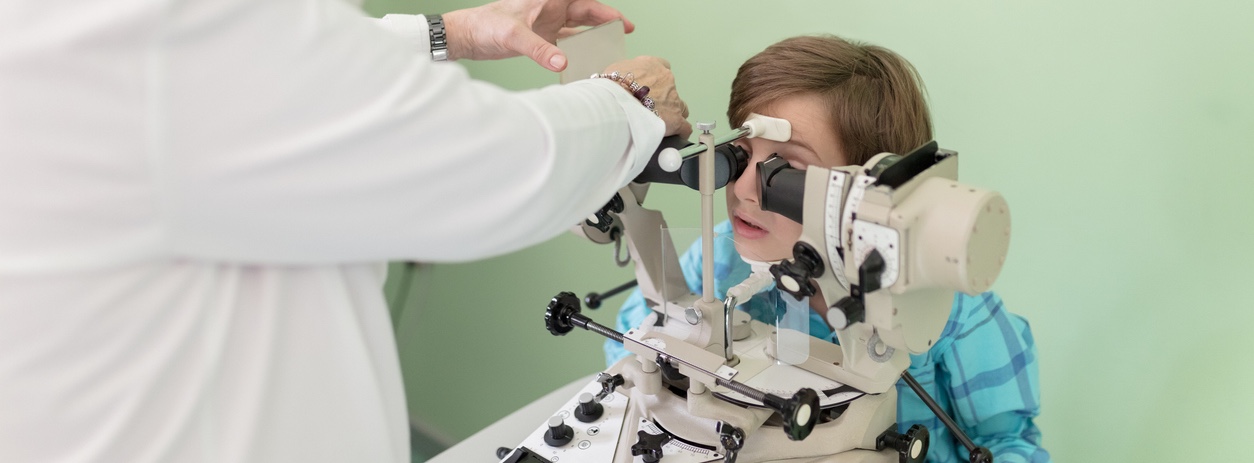Amblyopia Overview

Just because you see well does not mean your child does!
We often take it for granted that our children see as well as we do. This may not be the case if your child has a lazy eye or is cross eyed. Normal vision develops early in life when the brain learns to fuse the images from both the left and right eye forming a single image. This is referred to as binocularity. Lazy eye (amblyopia) on the other hand is a reduction in vision that results from abnormal visual development in infancy and early childhood. Amblyopia is the leading cause of decreased vision among children, affecting 2-3% of the population.
Amblyopia develops when the nerve pathways between the brain and eye are not properly stimulated. As a result, the brain favors the eye with the clearer image and turns off or blocks the image from the eye with poor vision. Turning off an eye is called suppression. As the brain suppresses the lazy eye early in life, clear vision does not have a chance to develop and both eyes are not used together, effectively resulting in reduced binocularity. Most cases of amblyopia affect only one eye, but some cases are bilateral.
Lazy eye is hereditary and commonly seen among children born prematurely or with a low birth weight, or in those who have a family history, childhood cataracts or a serious eye disease.
What causes amblyopia? (Lazy Eye)
Strabismus – The most common cause of lazy eye is strabismus (eye turn or wandering eye), an imbalance in the muscles responsible for aligning the eyes, resulting in one eye pointing in or out, up or down. When the eyes are not aligned, two different images are being sent to the brain resulting in double vision. The brain is then forced to turn off the image coming from the misaligned eye to create a single image. The child only uses his straight eye to see, and vision in the turned eye does not have a chance to develop.
Deprivation – The most severe type of amblyopia in terms of vision loss resulting from an obstruction that “deprives” the child of clear vision in the eye is deprivation. Examples include a cloudy area in the lens (cataract), droopy eyelid, or opacity.
Refractive – The result of a significant difference between the vision in each eye, due to nearsightedness, farsightedness or an imperfection on the surface of the eye (astigmatism) that makes it difficult for the eyes to focus together is refractive. An infant has no way of telling his parents that one of his eyes does not see as clear as the other. Since it is difficult for the visual system to fuse a clear image with a blurred image, the brain learns to suppress the blurred eye causing vision to stop developing in that eye.
Lazy Eye Symptoms & Signs
Signs and symptoms of lazy eye include:
- An eye that wanders in or out, up or down
- Eyes that may not appear to work together
- Poor depth perception (3D vision)
- Early eye examination is key to detection and diagnosis
We begin to see children as early as 6 months of age to screen for lazy eye and eye turns. As part of the examination, a thorough medical, ocular and family history is taken, visual acuity is assessed for each eye looking for differences in vision between the eyes or reduced in vision, and tests are done to check focusing, binocularity, eye teaming and eye tracking. The need for correction such as glasses and/or contact lenses and an ocular health assessment is also performed.
Is a lazy eye painful in any way?
It does not seem as though children with a lazy eye experience pain as a symptom. The consequences of the brain favoring one eye over the other are more visual in nature. The person with amblyopia may squint to try and bring objects into focus. They may have double vision and poor depth perception that causes them to bump into objects on the weaker side.
Can a lazy eye go away on its own?
No. Amblyopia does not go away on its own and cannot get better without proper treatment. Unless the lazy eye is treated, the brain will favor the stronger eye, resulting in the progressive weakening of the amblyopic eye. Parents of children with signs of a lazy eye are encouraged to seek care as soon as possible, and to commit to their nonsurgical treatment plan, such as patching, so surgery can be avoided if at all possible.
Background & Indication for Eye Muscle Surgery
Eye muscle surgery or “strabismus surgery” is an outpatient procedure. The goal of surgery is to surgically align your child’s eyes to better achieve binocular fusion (the eyes working together to give maximal depth perception) and to improve or normalize the field of vision (the total visual area, including “side vision”). Surgery is intended to align or straighten the eyes without much effort on the part of the child. Eye muscle surgery involves either tightening or weakening one or more of the six muscles on the surface of the eye. Nothing is done inside of the eye to change the vision. The eyes are never taken out during surgery.
When strabismus surgery is recommended, we feel that the risk of not doing surgery is higher than the risk of surgery. Each child heals differently. We carefully measure the amount of misalignment using prisms prior to surgery, so the correct amount of surgery can be accomplished.
Who is a candidate for lazy eye treatment?
Ideally, treatment for lazy eye will occur early in childhood. At this time, the child’s brain is still developing and has a greater chance of re-wiring its interpretation of signals from the optic nerve. In childhood, treatment for lazy eye nearly always begins with conservative therapies that strive to teach the brain to rely more on the weaker eye. Examples include patches and eye drops. Strabismus surgery to help align the eyes may be done on children and adults. However, the outcome in adult cases is purely cosmetic.
What should I expect from my results?
It can take several months to notice the final alignment of the eyes after amblyopia surgery. While appearance may improve, there is a chance that vision may not. This is because vision is ultimately controlled by the brain, not the eyes. Even after surgery, some patients may be advised to undergo vision therapy to reduce the symptoms of amblyopia.
How should you prepare for lazy eye treatment?
Lazy eye treatment can vary from one patient to another. The primary recommendation that doctors have is to see a specialist as soon as signs of poor vision are noticed. Once a comprehensive examination is performed, the doctor can better discuss the best course of action based on the severity of contrast between the strength of each eye. For nonsurgical treatments, there are few, if any, pretreatment guidelines. Before surgery, parents of patients may receive precise instructions regarding how to care for the eyes after surgery.
Lazy Eye Treatment

If a child is diagnosed with amblyopia, depending on the cause and the degree to which the vision is affected, treatment options can include:
- Corrective eyewear, such as glasses and/or contact lenses, to help equalize the vision in both eyes
- Eye patches to stimulate the weaker eye
- Eye drops to temporarily blur vision in the stronger eye in order to encourage the use of the weaker eye
- Vision therapy or eye exercises to help establish binocularity, focusing and eye tracking
- Surgery to align the eyes or correct the droopy eyelid or remove the cataract
Ideally, the earlier the treatment is initiated the better the outcome, as the connections between the eye and brain are forming. If a lazy eye is left untreated, permanent vision loss can occur.
What is recovery like?
Patients who undergo strabismus surgery to improve the alignment of the eyes can expect bruising, swelling, and minor discomfort. Bruising in an inevitable side effect that usually fades within two weeks. Discomfort is manageable with an over-the-counter pain reliever. Patients may also shed pink or reddish tears or mucus discharge from the eye. This side effect should last only a few days. Discharge can be gently wiped away with a clean, soft cloth.
The surface of the eye is often bright red after surgery for amblyopia. This is a type of bruising on the globe of the eye itself, not an indication of a complication from surgery. The redness may improve within a few days, but the healing process could take as long as a few months.
What People Say About Us!
"I was thoroughly impressed with Dr. Richens. She was everything one could hope for in a medical professional: attentive, thorough, professional, and a very skilled communicator. She took the time to listen and diagnose in a way that gave me confidence."
Click here to read more reviews.
Contact Us
Richens Eye Center proudly provides patients from St George UT, Mesquite NV, and surrounding areas with lazy eye treatment. If you or your child suffers from amblyopia, call or text us for a consultation with one of our providers at 435.986.2020 or fill out a Contact Form here.

